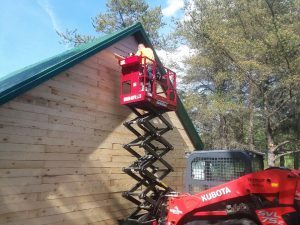Hansen Pole Buildings Designer Rick recently asked me this question about overhangs and F Channel:
“A question came up about soffit support.
The client is a builder trying to close a garage for his client. He asked about soffit/enclosed overhangs.
He asked why we do not use an F channel trim to hold the soffit in place on the wall side instead of wood frame soffit support, commenting that the F channel is less time consuming and more material efficient.”
 In typical stud wall construction, vinyl (aluminum or steel) soffit panels are typically held in place against the wall, by means of nailing a piece of trim known as “F and J’ to the wall of the building. This piece of trim has two “receiving” points, one horizontal to accept the soffit panels and the other below and vertical to accept the siding.
In typical stud wall construction, vinyl (aluminum or steel) soffit panels are typically held in place against the wall, by means of nailing a piece of trim known as “F and J’ to the wall of the building. This piece of trim has two “receiving” points, one horizontal to accept the soffit panels and the other below and vertical to accept the siding.
This makes for quick installation for the installer, as no fasteners are needed to be placed into the edge of the soffit panels, against the wall of the building – the F channel trim is relied upon to hold the soffit in place.
A stud wall is going to obviously be fairly rigid in the horizontal direction. All of those studs (whether 16 or 24 inches on center) are not going to bend.
In post frame (pole building) construction, regardless of how close together the columns are spaced, there is going to be a fair distance between them. There are numerous suppliers and builders who ignore this, and will place a single (usually 2×4) framing member flat on the outside of the columns. They try to get by with attaching F and J trim against it, just like they would in stick frame (stud wall) applications.
The downside of this application is the single framing member is going to have a fairly large amount of flex. In an extreme wind situation, the member could easily flex far enough to allow the soffit panels in the middle of the span to fall out of the receiving end of the trim. Not good.
From years of experience (and finding out the hard way what doesn’t work), we came up with a solution which has eliminated the deflection issues. Against the pole building columns, we place two 2x4s nailed together to form an “L”.
This L, keeps the edge of the soffit closest to the building wall from being able to flex either up and down, or in and out. It provides a solid anchorage point – keeping the soffit panels where they belong, securely attached in place.






